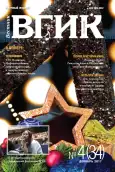Criteria of Composition of Documentaries about Nature
- Authors: Berkova N.N1
-
Affiliations:
- Казахская национальная академия искусств им. Т.К. Жургенова
- Issue: Vol 9, No 4 (2017)
- Pages: 71-82
- Section: PERFORMANCE | ART OF PRESENTATION
- URL: https://journals.eco-vector.com/2074-0832/article/view/14618
- DOI: https://doi.org/10.17816/VGIK9471-82
- ID: 14618
Cite item
Full Text
Abstract
The author analyses the challenging issue of audiovisual material organisation in documentaries which has not yet received ample attention. It is shown how assembly-rhythmic construction of audiovisual forms with frame accentuation points out the completeness of a film composition. The author draws attention to the films about ecology, or alternatively about the interaction between nature and society. It is analysed how basic accentual frames connect the parts of the whole by using distant assembling, harmonizing the structure of the documentary by means of artistic and poetic devices (in technical terms - optical methods), providing visual and sensual perception of images in certain rhythm. For the analysis the author has selected a series of films: Inhabitants, The Seasons of the Year by A. Peleshyan, where the composition is united by triple repetition of the same pictures, Salty Tears of Turan by V. Belyalov and L. Muhametgalieva, containing triple picture shifts with petrogliphs (ancient stone art), Golovnev's Little Katerina with the composition structured by triple picture shift with the use of one camera technique. In his documentary Brothers and birds S. Bychenko uses triple or quadruple picture shift by applying triple/ quadruple exposition and by supplying documentary shots with quotations. The thesis of assembly-rhythmic film construction is grounded on the base of the number “three”. Thus the documentary material is organized according to the "laws of organic nature phenomena structure" (Sergei Eisenstein), which are included in the recommended methods for art creation. But this does not mean that the techniques in question can be incorporated as a canon. Film language develops in the process of searching experiments. Feeling/understanding of the rhythmical construction, as well as knowledge of the laws of art, correlated with the above mentioned contributes to the creation of works that would have inspiring persuasive force.
About the authors
Nadezhda N Berkova
Казахская национальная академия искусств им. Т.К. Жургенова
Author for correspondence.
Email: editor@vestnik-vgik.com
Assistant Professor of Cinema History and Theory Department Kazakh National Academy of Arts n. a. T.K. Zhurgenov.
Алма-Ата, КазахстанReferences
- Аронсон О. Артавазд Пелешян. Мгновение человечества // URL.: 05/08/2008.http://os.colta.ru/cinema/projects/67/details/2261 (дата обращения: 30.03. 2017).
- Беркова Н.Н. К вопросу об идейно-тематической направленности фильмов о взаимодействии общества и природы / Н.Н. Беркова // В мире науки и искусства: вопросы филологии, искусствоведения и культурологии / Сб. ст. по материалам XXXI междунар. науч.- практ.конф. № 12 (31). - Новосибирск: Изд. «СибАК», 2013. - С. 58-66.
- Быченко С.Н. Поняла, почему взрослые мужчины, рассказывая о глухарях, плачут // URL.: http://tvkultura.ru/article/show/article_id/11535 (дата обращения: 30.03.2017).
- Гегель Г.В.Ф. Эстетика: в 4 т. / Гегель. - М.: Искусство, 1969. - Т. 2. - 328 с.
- Мифы народов мира: в 2 т. - М.: Советская энциклопедия, 1991. - Т. 2. - 719 с.
- Пелешян А.А. Мое кино. Сборник сценариев / А.А. Пелешян. - Ереван: Советакан Грох, 1988. - 256 с.
- Эйзенштейн С.М. Неравнодушная природа: в 2 т. / С.М. Эйзенштейн. - М.: Музей кино. Эйзенштейн-центр, 2006. - Т. 2. О строении вещей. - 624 с.
- Ямпольский М. Схема? Свободная стихия! О творческом методе А. Пелешяна: Илья Вайсфельд, Виктор Шкловский, Юрий Лотман / М.: Ямпольский // Искусство кино, 1988, № 4. - С. 60-71.
Supplementary files








